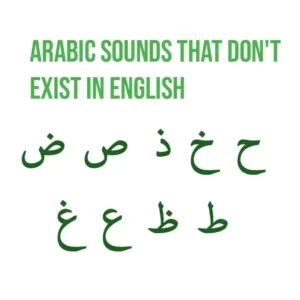12 Arabic Pronouns With Examples That Will Make Your Sentences Flow

Understanding Arabic pronouns is very important because they are used in everyday conversation. Mastering them will help you learn Arabic more effectively. First, let’s look at how pronouns fit into Arabic grammar.
Arabic pronouns include:
- Personal Pronouns: These refer to the speaker, the person being spoken to, or the person or thing being talked about.
- Indefinite Pronouns: These refer to non-specific things or people.
- Relative Pronouns: These link different parts of a sentence together.
- Reciprocal or Reflexive Pronouns: These show that the action of a verb is directed back at the subject.
Arabic pronouns can be complex because they have different forms for masculine and feminine, and they include special forms for addressing two people or things.
What is a Pronoun Called in Arabic?
Pronoun is called الضَّمِيْر pronounced as Dhamir in Arabic language. The plural of Arabic pronoun is written as الضمائر and pronounced as dhama’ir.
Arabic pronouns are words used to replace nouns and indicate who or what is being referred to. Here’s a detailed overview of Arabic pronouns:
1. Personal Pronouns
Personal pronouns represent specific people and vary depending on gender, number, and case.
Singular Pronouns
| Pronoun | English | Arabic Script | Transliteration |
|---|---|---|---|
| I | I | أنا | ana |
| You (masc.) | You | أنتَ | anta |
| You (fem.) | You | أنتِ | anti |
| He | He | هو | huwa |
| She | She | هي | hiya |
Dual Pronouns
Arabic has a unique form for addressing two people or things.
| Pronoun | English | Arabic Script | Transliteration |
|---|---|---|---|
| We (two) | We (two) | نحنُ | naḥnu |
| You (two, masc.) | You (two) | أنتما | antumā |
| You (two, fem.) | You (two) | أنتما | antumā |
| They (two, masc.) | They (two) | هما | humā |
| They (two, fem.) | They (two) | هما | humā |
Plural Pronouns
| Pronoun | English | Arabic Script | Transliteration |
|---|---|---|---|
| We | We | نحنُ | naḥnu |
| You (masc. pl.) | You (plural) | أنتم | antum |
| You (fem. pl.) | You (plural) | أنتنَّ | antunna |
| They (masc.) | They | هم | hum |
| They (fem.) | They | هنَّ | hunnā |
2. Possessive Pronouns
Possessive pronouns show ownership and are attached to nouns.
Singular Possessive Pronouns
| Pronoun | English | Arabic Script | Transliteration |
|---|---|---|---|
| My | My | ـيـ / -ي | -ī |
| Your (masc.) | Your | ـكَ / -ka | -ka |
| Your (fem.) | Your | ـكِ / -ki | -ki |
| His | His | ـهُ / -hu | -hu |
| Her | Her | ـهـا / -hā | -hā |
Dual and Plural Possessive Pronouns
| Pronoun | English | Arabic Script | Transliteration |
|---|---|---|---|
| Our | Our | ـنا / -nā | -nā |
| Your (two, masc.) | Your (two) | ـكما / -kumā | -kumā |
| Your (two, fem.) | Your (two) | ـكما / -kumā | -kumā |
| Their (two, masc.) | Their (two) | ـهما / -humā | -humā |
| Their (two, fem.) | Their (two) | ـهما / -humā | -humā |
| Your (masc. pl.) | Your | ـكم / -kum | -kum |
| Your (fem. pl.) | Your | ـكنَّ / -kunnā | -kunnā |
| Their (masc.) | Their | ـهم / -hum | -hum |
| Their (fem.) | Their | ـهنَّ / -hunnā | -hunnā |
Summary
- Personal Pronouns: Represent people or things directly and change based on number (singular, dual, plural), gender (masculine, feminine), and case.
- Possessive Pronouns: Indicate ownership and are attached to nouns.
These pronouns are crucial for constructing sentences and expressing relationships and possession in Arabic.
READ ALSO: 10 Arabic Question Words (Arabic Interrogatives) With Examples
Subject Pronouns in Arabic
Subject pronouns are words used to indicate who is performing the action in a sentence. In Arabic, subject pronouns change based on who or what is being talked about (i.e., the speaker, the listener, or someone else), and they vary depending on number (singular, dual, plural) and gender (masculine, feminine).
Here’s a detailed look at subject pronouns in Arabic:
Singular Subject Pronouns
- أنا (ana) – “I”
- Used when the speaker is talking about themselves.
- Example: أنا طالب (ana ṭālib) – “I am a student.”
- أنتَ (anta) – “You” (masculine)
- Used when speaking to a male.
- Example: أنتَ معلم (anta muʿallim) – “You are a teacher.”
- أنتِ (anti) – “You” (feminine)
- Used when speaking to a female.
- Example: أنتِ طبيبة (anti ṭabība) – “You are a doctor.”
- هو (huwa) – “He”
- Used when talking about a male.
- Example: هو مهندس (huwa muhandis) – “He is an engineer.”
- هي (hiya) – “She”
- Used when talking about a female.
- Example: هي طالبة (hiya ṭāliba) – “She is a student.”
Dual Subject Pronouns
Arabic has special pronouns for referring to two people or things.
- نحنُ (naḥnu) – “We” (for two people)
- Used when talking about the speaker and one other person.
- Example: نحنُ ندرس (naḥnu nadrus) – “We are studying.”
- أنتما (antumā) – “You” (for two people)
- Used when addressing two people.
- Example: أنتما صديقان (antumā ṣadīqān) – “You (two) are friends.”
- هما (humā) – “They” (for two people)
- Used when talking about two people.
- Example: هما مدرسان (humā mudarrisān) – “They (two) are teachers.”
Plural Subject Pronouns
- نحنُ (naḥnu) – “We” (for more than two people)
- Used when talking about the speaker and multiple others.
- Example: نحنُ نعمل (naḥnu naʿmal) – “We are working.”
- أنتم (antum) – “You” (masculine plural)
- Used when addressing a group of males or a mixed-gender group.
- Example: أنتم طلاب (antum ṭullāb) – “You (all) are students.”
- أنتنَّ (antunna) – “You” (feminine plural)
- Used when addressing a group of females.
- Example: أنتنَّ معلمات (antunna muʿallimāt) – “You (all) are teachers.”
- هم (hum) – “They” (masculine plural)
- Used when talking about a group of males or a mixed-gender group.
- Example: هم مهندسون (hum muhandisūn) – “They (all) are engineers.”
- هنَّ (hunnā) – “They” (feminine plural)
- Used when talking about a group of females.
- Example: هنَّ طبيبات (hunnā ṭabībāt) – “They (all) are doctors.”
Summary
- Singular Pronouns: Use “أنا” for “I”, “أنتَ” for “you” (masculine), “أنتِ” for “you” (feminine), “هو” for “he”, and “هي” for “she”.
- Dual Pronouns: Use “نحنُ” for “we” (two), “أنتما” for “you” (two), and “هما” for “they” (two).
- Plural Pronouns: Use “نحنُ” for “we” (more than two), “أنتم” for “you” (masculine plural), “أنتنَّ” for “you” (feminine plural), “هم” for “they” (masculine plural), and “هنَّ” for “they” (feminine plural).
These pronouns help identify who is doing the action in a sentence and are crucial for forming grammatically correct sentences in Arabic.
Arabic Object Pronouns
Object pronouns are used to indicate the receiver of an action in a sentence. In Arabic, object pronouns are attached to verbs, prepositions, and some nouns to show who or what is affected by the action.
Here’s a detailed explanation of Arabic object pronouns:
Singular Object Pronouns
- ـني (-nī) – “Me”
- Used as the object of a verb.
- Example: ساعدني (sāʿidnī) – “Help me.”
- ـكَ (-ka) – “You” (masc.)
- Used when addressing a male.
- Example: أراكَ (arāk), which means “I see you.”
- ـكِ (-ki) – “You” (fem.)
- Used when addressing a female.
- Example: أسمعكِ (asmʿuki), which means “I hear you.”
- ـهُ (-hu) – “Him”
- Used when referring to a male.
- Example: رأيتهُ (raʾaytuhu), which means “I saw him.”
- ـها (-hā) – “Her”
- Used when referring to a female.
- Example: سمعتها (samiʿtuhā), which means “I heard her.”
Dual Object Pronouns
- ـنا (-nā) – “Us” (for two people)
- Used as the object of a verb for two people.
- Example: ساعدنا (sāʿidnā), which means “Help us.”
- ـكما (-kumā) – “You” (for two people)
- Used when addressing two people.
- Example: أراكما (arākumā), which means “I see you (both).”
- ـهما (-humā) – “Them” (for two people)
- Used when referring to two people.
- Example: رأيتهما (raʾaytuhumā), which means “I saw them (both).”
Plural Object Pronouns
- ـنا (-nā) – “Us” (for more than two people)
- Used as the object of a verb for a group.
- Example: ساعدنا (sāʿidnā), which means “Help us.”
- ـكم (-kum) – “You” (masc. plural)
- Used when addressing a group of males or a mixed-gender group.
- Example: أراكم (arākum), which means “I see you (all).”
- ـكنَّ (-kunnā) – “You” (fem. plural)
- Used when addressing a group of females.
- Example: أراكنَّ (arākunna), which means “I see you (all).”
- ـهم (-hum) – “Them” (masc. plural)
- Used when referring to a group of males or a mixed-gender group.
- Example: رأيتهم (raʾaytuhum), which means “I saw them.”
- ـهنَّ (-hunnā) – “Them” (fem. plural)
- Used when referring to a group of females.
- Example: رأيتهنَّ (raʾaytuhunnā), which means “I saw them (females).”
Summary
- Singular Object Pronouns include “ـني” (-nī) for “me,” “ـكَ” (-ka) for “you” (masc.), “ـكِ” (-ki) for “you” (fem.), “ـهُ” (-hu) for “him,” and “ـها” (-hā) for “her.”
- Dual Object Pronouns include “ـنا” (-nā) for “us” (two), “ـكما” (-kumā) for “you” (two people), and “ـهما” (-humā) for “them” (two people).
- Plural Object Pronouns include “ـنا” (-nā) for “us” (more than two), “ـكم” (-kum) for “you” (masc. plural), “ـكنَّ” (-kunnā) for “you” (fem. plural), “ـهم” (-hum) for “them” (masc. plural), and “ـهنَّ” (-hunnā) for “them” (fem. plural).
These object pronouns are essential for forming complete sentences and making clear who or what is receiving the action.
Determinative Possessive Pronouns in Arabic
Determinative possessive pronouns in Arabic are used to show ownership or possession. They are attached to nouns to indicate who owns or possesses something.
These pronouns come in different forms based on the number of possessors (singular, dual, plural) and their gender (masculine, feminine).
Here’s a detailed look at how determinative possessive pronouns work in Arabic:
Singular Possessive Pronouns
- ـي (-ī) – “My”
- Used to indicate that something belongs to the speaker.
- Example: كتابي (kitābī) – “My book.”
- ـكَ (-ka) – “Your” (masculine)
- Used to indicate that something belongs to the person being spoken to (male).
- Example: كتابكَ (kitābuka) – “Your book” (male).
- ـكِ (-ki) – “Your” (feminine)
- Used to indicate that something belongs to the person being spoken to (female).
- Example: كتابكِ (kitābuki) – “Your book” (female).
- ـهُ (-hu) – “His”
- Used to indicate that something belongs to a male.
- Example: كتابهُ (kitābuhu) – “His book.”
- ـها (-hā) – “Her”
- Used to indicate that something belongs to a female.
- Example: كتابها (kitābuhā) – “Her book.”
Dual Possessive Pronouns
- ـنا (-nā) – “Our” (for two people)
- Used to indicate that something belongs to both the speaker and another person.
- Example: كتابنا (kitābnā) – “Our book.”
- ـكما (-kumā) – “Your” (for two people)
- Used to indicate that something belongs to two people being addressed.
- Example: كتابكما (kitābukumā) – “Your book” (for two people).
- ـهما (-humā) – “Their” (for two people)
- Used to indicate that something belongs to two people being talked about.
- Example: كتابهما (kitābuhumā) – “Their book” (for two people).
Plural Possessive Pronouns
- ـنا (-nā) – “Our” (for more than two people)
- Used to indicate that something belongs to the speaker and others.
- Example: كتابنا (kitābnā) – “Our book.”
- ـكم (-kum) – “Your” (masculine plural)
- Used to indicate that something belongs to a group of males or a mixed-gender group.
- Example: كتابكم (kitābukum) – “Your book” (masculine plural).
- ـكنَّ (-kunnā) – “Your” (feminine plural)
- Used to indicate that something belongs to a group of females.
- Example: كتابكنَّ (kitābukunnā) – “Your book” (feminine plural).
- ـهم (-hum) – “Their” (masculine plural)
- Used to indicate that something belongs to a group of males or a mixed-gender group.
- Example: كتابهم (kitābuhum) – “Their book.”
- ـهنَّ (-hunnā) – “Their” (feminine plural)
- Used to indicate that something belongs to a group of females.
- Example: كتابهنَّ (kitābuhunnā) – “Their book.”
Summary
- Singular Possessive Pronouns: “ـي” (-ī) for “my,” “ـكَ” (-ka) for “your” (masc.), “ـكِ” (-ki) for “your” (fem.), “ـهُ” (-hu) for “his,” and “ـها” (-hā) for “her.”
- Dual Possessive Pronouns: “ـنا” (-nā) for “our” (two), “ـكما” (-kumā) for “your” (two people), and “ـهما” (-humā) for “their” (two people).
- Plural Possessive Pronouns: “ـنا” (-nā) for “our” (more than two), “ـكم” (-kum) for “your” (masc. plural), “ـكنَّ” (-kunnā) for “your” (fem. plural), “ـهم” (-hum) for “their” (masc. plural), and “ـهنَّ” (-hunnā) for “their” (fem. plural).
These possessive pronouns help specify ownership and are essential for clear and accurate communication in Arabic.
Types of Arabic Pronouns
In Arabic grammar, pronouns can be categorized into several types based on their usage and visibility in sentences. Here’s a breakdown of these types:
1. Covert Pronouns (مُسْتَتِر – Mustatir)
Covert pronouns are not explicitly written or pronounced. They are implied within the context of the sentence. They are understood through the verb conjugation or the structure of the sentence.
- Example: In the sentence “أكتبُ رسالةً” (ʾaktubu risālatan), meaning “I write a letter,” the pronoun “I” is not explicitly stated but is implied by the verb form “أكتبُ” (ʾaktubu).
2. Overt Pronouns (ظَاهِر – Dhāhir)
Overt pronouns are explicitly written and pronounced. They can be further divided into:
a. Separate Pronouns (مُنْفَصِل – Munfasil)
Separate pronouns are used independently in a sentence and are not attached to verbs or other words. They usually appear at the beginning of a sentence or as the subject.
- Examples:
- أنا (ana) – “I”
- Example: أنا طالب (ana ṭālib) – “I am a student.”
- أنتَ (anta) – “You” (masculine)
- Example: أنتَ معلم (anta muʿallim) – “You are a teacher.”
- هو (huwa) – “He”
- Example: هو طبيب (huwa ṭabīb) – “He is a doctor.”
b. Attached Pronouns (مُتَّصِل – Muttasil)
Attached pronouns are affixed to verbs, prepositions, or nouns to show who is performing or receiving the action. They appear as suffixes.
- Examples:
- ـني (-nī) – “Me”
- Example: ساعدني (sāʿidnī) – “Help me.”
- ـهُ (-hu) – “Him”
- Example: رأيتهُ (raʾaytuhu) – “I saw him.”
- ـها (-hā) – “Her”
- Example: سمعتها (samiʿtuhā) – “I heard her.”

Summary
- Covert Pronouns (مُسْتَتِر – Mustatir): Implied in the sentence but not written or pronounced. They are understood through the context or verb form.
- Overt Pronouns (ظَاهِر – Dhāhir): Explicitly written and pronounced. They are divided into:
- Separate Pronouns (مُنْفَصِل – Munfasil): Stand-alone pronouns like أنا (ana) for “I” and هو (huwa) for “he.”
- Attached Pronouns (مُتَّصِل – Muttasil): Suffixes attached to verbs, prepositions, or nouns, such as ـني (-nī) for “me” and ـهُ (-hu) for “him.”
Understanding these pronouns helps in forming clear and grammatically correct sentences in Arabic.






